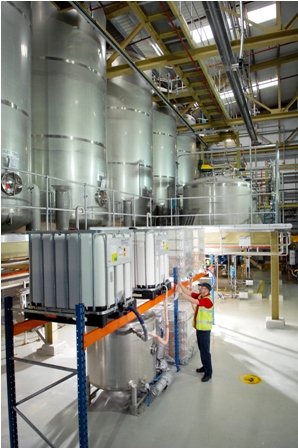Personal wash producer PZ Cussons built a fully-automated plant from the ground up. Benefits included improved asset and production performance with stringent quality standards.

Leading personal wash company, PZ Cussons, has invested in a new U.K. high-speed liquid product manufacturing facility, significantly increasing capacity as well as benefitting from a more efficient process. Its old site, which had grown organically over a long period of time, was unable to deliver sufficient production volumes to satisfy the economies of scale necessary to meet business demands. It also required too much operator intervention at virtually all stages of manufacturing, which often introduced unwanted levels of product variability. The company knew that it needed to reduce production costs and recognized that only a modern process plant would help it to realize that goal.
Challenge
As part of a complete overhaul and modernization of its U.K. supply chain, PZ Cussons decided to take advantage of the control and visibility capabilities offered by modern process automation infrastructure. While establishing the justification for a new domestic manufacturing facility, the company realized that much of its existing process equipment at its old site was simply not up to the demands of a modern manufacturing environment. This is one of the reasons why it chose to start with a clean slate in order to take advantage of current technologies. The company approached Rockwell Automation and its alliance partner Endress+Hauser to implement the project. The scope began with ISA S-88 standard manufacturing concepts, using networked instrumentation and routing valves. The whole system was to be built within a common software environment with scalability to allow straightforward expansion and cross-line migration.
With an opportunity to start from scratch, PZ Cussons recognized many areas where savings could be made by removing unnecessary costs. It also wanted to adopt leaner manufacturing procedures making further savings with reduced inventories and quicker deliveries. The primary challenge was to obtain visibility of all steps of the process and to keep all parameters within operational tolerances. This required extremely accurate batching, mixing, and metering systems, which could not only communicate with each other, but also with the master control system within the offices and external suppliers via a secure extranet.
Benefits of continuous production
An entirely new processing and production operation was developed, controlled by equipment engineered and supplied by Rockwell Automation, along with instruments and fieldbus networks designed and commissioned by Endress+Hauser. The implementation of the project made full use of the improved process and diagnostic data that fieldbus networked devices provide.
Each of the five production lines uses similar configurations:
• One Profibus DP segment, with three flowmeters and four weight transmitters;
• One Profibus PA segment, with 12 to 15 pressure, level, and temperature devices, plus one control valve with a Samson positioner; and
• Two ASi segments with a total of approximately 45 valves.
The minors area has:
• Five Profibus DP segments with 11 flowmeters and 12 weight transmitters;
• Three Profibus PA segments with a total of 58 devices, including pressure, level, temperature, and pH; and
• Four ASi segments with a total of 61 valves.
The motor control centers (MCC’s) on each line and in the minors area use DeviceNet. There are also hard-wired devices for shutdown and safety systems.
This networking has given the company a level of process visibility and control far beyond what it had in its older plant. The new approach is helping it to attain many of the savings it hoped for, while also removing much of the process variability which introduced unwanted costs.
By measuring and automating virtually every step of the recipe creation, mixing, processing, and packaging lines, the larger automation solution has had a significant impact. Not only has the control system supported the required production volumes, but with seamless integration of the field devices, their accuracy has provided data necessary for meeting quality targets. The savings have been such that the company has been able to justify its decision to keep production in the U.K. and not pursue offshore options.
The new PlantPAx process automation system uses a combination of technologies to achieve the production and quality targets. Overall line control is supported by a number of cabinet mounted, line-side Allen-Bradley ControlLogix PACs. As well as providing the core control for Allen-Bradley intelligent MCCs, the controllers also link to FactoryTalk platforms, including Batch and supply data for Historian. The Asset Center tool provides plant-wide asset management support. The whole installation is also covered by a strategic maintenance contract, with team support should there be any primary system problems.
Manufacturing processes
In day-to-day operation, the factory receives bulk raw materials and combines them with precisely-dosed quantities of perfumes and additives following a set list of recipes. The batches are mixed and packaged according to production volume needs. Although simple in theory, the entire process requires extremely high levels of measurement and control so that batches fall within the company’s stringent quality standards.
According to Andy Ellams, PZ Cussons’ process development manager, "We had a very clear view of what we wanted – a distributed control system which runs off a set of servers integrated into our general IT infrastructure. These servers are connected to the PLCs on a fiber optic network which is shared with our office systems traffic."
The field instrumentation can be maintained and configured from a central location using the FDT/DTM capabilities of Endress+Hauser’s FieldCare. The fieldbus networks also facilitate central monitoring and analysis of communication traffic. This provides seamless integration from the control system to field devices providing validation of measured variables and consistent device maintenance.
Changing operator roles
PZ Cussons has effectively been able to move operator skills and knowledge into the automation architecture. Formerly this depended on experience and knowledge that took operators many years to learn. Even then, most of the operators had their own way of doing things on each of the machines, which became the source of some of the process variability. Labor in one area has been reduced from 16 people on a four-shift pattern to just one person who only needs to visit the section once a day. Some of these individuals’ roles have been redeployed elsewhere in the factory.
With the old approach, all of the recipes were hard coded into the PLCs so there was no easy way to test new formulas and mixes without a significant code writing exercise. Rockwell Automation’s technology has allowed the company to pilot test new recipes on a small scale prior to mass production. Previously there was a need for specialist operators, but with the new system, thanks to the consistency and portability of the software, any operator can now run any line. Operators are now much more multi-skilled, adding value to the areas where their intervention really counts.
Ellams concludes, "First-time passes are now becoming the norm. The quality standards we are seeing are very high with little or no tweaking required. We often go weeks without any production issues." Overall, the plant is experiencing reduced downtime, greater accuracy, and shorter batch times. This also saves energy and speeds up time to market.



